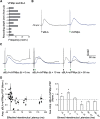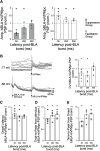Synaptic Integration of Thalamic and Limbic Inputs in Rodent Gustatory Cortex
- PMID: 32019871
- PMCID: PMC7029183
- DOI: 10.1523/ENEURO.0199-19.2019
Synaptic Integration of Thalamic and Limbic Inputs in Rodent Gustatory Cortex
Abstract
Neurons in the gustatory cortex (GC) process multiple aspects of a tasting experience, encoding not only the physiochemical identity of tastes, but also their anticipation and hedonic value. Information pertaining to these stimulus features is relayed to GC via the gustatory thalamus (VPMpc) and basolateral amygdala (BLA). It is not known whether these inputs drive separate groups of neurons, thus activating separate channels of information, or are integrated by neurons that receive both afferents. Here, we used anterograde labeling and in vivo intracellular recordings in anesthetized rats to assess the potential convergence of BLA and VPMpc inputs in GC, and to investigate the dynamics of integration of these inputs. We report substantial anatomic overlap of BLA and VPMpc axonal fields across GC, and identify a population of GC neurons receiving converging BLA and VPMpc inputs. Our data show that BLA modulates the gain of VPMpc-evoked responses in a time-dependent fashion and that this modulation is dependent on the recruitment of synaptic inhibition by both BLA and VPMpc. Our results suggest that BLA shapes cortical processing of thalamic inputs by dynamically gating the excitatory/inhibitory balance of the GC circuit.
Keywords: amygdalocortical; excitation; gustatory cortex; inhibition; integration; thalamocortical.
Copyright © 2020 Stone et al.
Figures








Similar articles
-
Inhibitory Gating of Thalamocortical Inputs onto Rat Gustatory Insular Cortex.J Neurosci. 2023 Nov 1;43(44):7294-7306. doi: 10.1523/JNEUROSCI.2255-22.2023. Epub 2023 Sep 13. J Neurosci. 2023. PMID: 37704374 Free PMC article.
-
State Dependency of Chemosensory Coding in the Gustatory Thalamus (VPMpc) of Alert Rats.J Neurosci. 2015 Nov 25;35(47):15479-91. doi: 10.1523/JNEUROSCI.0839-15.2015. J Neurosci. 2015. PMID: 26609147 Free PMC article.
-
Laminar- and Target-Specific Amygdalar Inputs in Rat Primary Gustatory Cortex.J Neurosci. 2016 Mar 2;36(9):2623-37. doi: 10.1523/JNEUROSCI.3224-15.2016. J Neurosci. 2016. PMID: 26937004 Free PMC article.
-
Dual separate pathways for sensory and hedonic aspects of taste.Brain Res Bull. 2004 Jan 15;62(4):271-83. doi: 10.1016/j.brainresbull.2003.10.004. Brain Res Bull. 2004. PMID: 14709342 Review.
-
Convergence of primary sensory cortex and cerebellar nuclei pathways in the whisker system.Neuroscience. 2018 Jan 1;368:229-239. doi: 10.1016/j.neuroscience.2017.07.036. Epub 2017 Jul 22. Neuroscience. 2018. PMID: 28743454 Review.
Cited by
-
Glucagon-Like Peptide 1 and Taste Perception: From Molecular Mechanisms to Potential Clinical Implications.Int J Mol Sci. 2021 Jan 18;22(2):902. doi: 10.3390/ijms22020902. Int J Mol Sci. 2021. PMID: 33477478 Free PMC article. Review.
-
Cellular activity in insular cortex across seconds to hours: Sensations and predictions of bodily states.Neuron. 2021 Nov 17;109(22):3576-3593. doi: 10.1016/j.neuron.2021.08.036. Epub 2021 Sep 27. Neuron. 2021. PMID: 34582784 Free PMC article. Review.
-
Rethinking the role of taste processing in insular cortex and forebrain circuits.Curr Opin Physiol. 2021 Apr;20:52-56. doi: 10.1016/j.cophys.2020.12.009. Epub 2021 Jan 16. Curr Opin Physiol. 2021. PMID: 33681544 Free PMC article.
-
Intrinsic Excitability in Layer IV-VI Anterior Insula to Basolateral Amygdala Projection Neurons Correlates with the Confidence of Taste Valence Encoding.eNeuro. 2023 Jan 18;10(1):ENEURO.0302-22.2022. doi: 10.1523/ENEURO.0302-22.2022. Print 2023 Jan. eNeuro. 2023. PMID: 36635250 Free PMC article.
-
Inhibitory Gating of Thalamocortical Inputs onto Rat Gustatory Insular Cortex.J Neurosci. 2023 Nov 1;43(44):7294-7306. doi: 10.1523/JNEUROSCI.2255-22.2023. Epub 2023 Sep 13. J Neurosci. 2023. PMID: 37704374 Free PMC article.
References
Publication types
MeSH terms
Grants and funding
LinkOut - more resources
Full Text Sources
Miscellaneous
